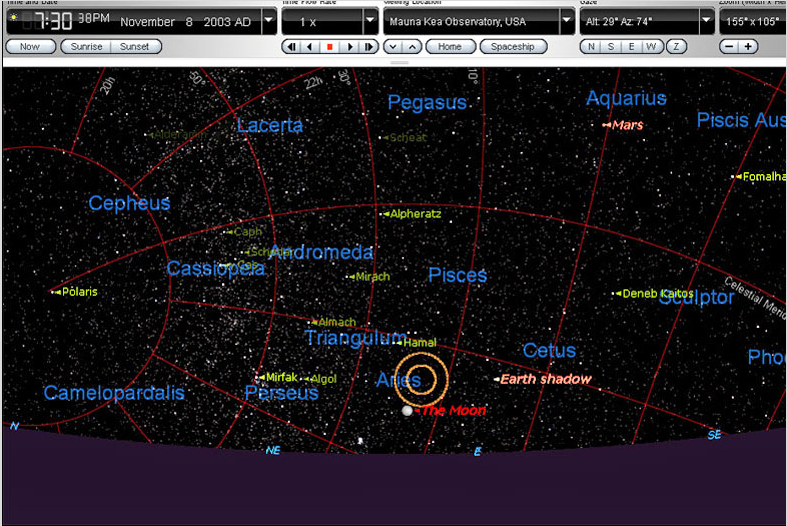Mauna Kea Shadow II
Mauna Kea Shadow II: Exploring the Phenomenon
In the realm of atmospheric optics, the captivating Mauna Kea Shadow II image by Michael Connelley has piqued the curiosity of many. This remarkable photograph showcases an almost full moon rising, while the shadow of Mauna Kea extends through the atmosphere, rather than being cast upon the clouds. Let's delve into this intriguing phenomenon and unravel the science behind it.
The tip of the mountain shadow, also known as the antisolar point, serves as a significant marker. Interestingly, it is at this point where the Earth's shadow converges. Surprisingly, the Earth's shadow extends far beyond the Moon. This raises a thought-provoking question: why is the Moon not eclipsed by this colossal shadow? Dale Ireland, a knowledgeable researcher, provides us with an explanation.
According to Ireland, at the Moon's distance from Earth, the Earth's shadow is merely a few Moon diameters wide. Moreover, it aligns precisely with the apex of the mountain shadow. In the captivating Mauna Kea Shadow II image, we observe that the (almost) full moon is situated just outside the Earth's shadow. This occurrence is common during most full moons, as the moon typically passes above or below the Earth's shadow or umbra. Only when it directly intersects with the Earth's shadow does a lunar eclipse occur.
Upon further investigation by Dale Ireland, it was discovered that the image corresponds to the moonrise of November 8th, 2003 (November 9th UT). Remarkably, this particular moonrise occurred shortly after the conclusion of a lunar eclipse. By referring to a map of that moment, we can observe that the orange circles mark the position of the Earth's shadow umbra and penumbra at the distance of the Moon.
The Mauna Kea Shadow II image serves as a testament to the breathtaking beauty of atmospheric optics. By examining this captivating photograph, we can appreciate the intricate interplay between celestial bodies and their shadows. Let us now explore some key takeaways from this remarkable phenomenon:
- The Mauna Kea Shadow II image showcases an almost full moon rising, with the shadow of Mauna Kea extending through the atmosphere.
- The tip of the mountain shadow marks the antisolar point, where the Earth's shadow converges.
- Despite the Earth's shadow extending far beyond the Moon, lunar eclipses occur only when the Moon intersects directly with the Earth's shadow.
- At the Moon's distance, the Earth's shadow is only a few Moon diameters wide, aligning with the apex of the mountain shadow.
- During most full moons, the Moon passes above or below the Earth's shadow or umbra, resulting in it not being eclipsed.
- The Mauna Kea Shadow II image corresponds to the moonrise following a lunar eclipse on November 8th, 2003.
- By referring to a map of that moment, we can visualize the position of the Earth's shadow umbra and penumbra at the distance of the Moon.
The Mauna Kea Shadow II image serves as a mesmerizing reminder of the wonders that unfold in our atmosphere. It sparks curiosity and encourages us to explore further into the intricate phenomena occurring above us. As we delve into the realm of atmospheric optics, we unlock a world of captivating beauty and scientific marvels, waiting to be discovered.

Michael Connelley's image of Mauna Kea's shadow shows an almost full moon rising. It makes the point that the mountain shadow extends through the atmosphere rather than being cast upon the clouds. Image ©Michael Cnnelley, shown with permission.
The tip of the mountain shadow marks the antisolar point. The Earth's shadow itself converges on this point. It also extends far beyond the Moon. Why then is the Moon not eclipsed? Dale Ireland (site) provides the explanation: "At the Moon's distance the Earth's shadow is just a few Moon diameters wide and it is located at the same place as the apex of the mountain shadow. In the image the (almost) full moon is just outside the Earth's shadow. This happens at most full moons. The moon passes above or below the Earth's shadow or umbra. If it hits the earth's shadow then there is a lunar eclipse.". Dale further researched when the image was taken - "It appears to match up with the moonrise of 08 Nov 2003 (09 Nov UT) which was actually just after the end of a lunar eclipse. Here is a map of the moment. The orange circles mark the position of the Earth's shadow umbra and penumbra at the distance of the Moon."

Note: this article has been automatically converted from the old site and may not appear as intended. You can find the original article here.
Reference Atmospheric Optics
If you use any of the definitions, information, or data presented on Atmospheric Optics, please copy the link or reference below to properly credit us as the reference source. Thank you!
-
<a href="https://atoptics.co.uk/blog/mauna-kea-shadow-ii/">Mauna Kea Shadow II</a>
-
"Mauna Kea Shadow II". Atmospheric Optics. Accessed on November 26, 2024. https://atoptics.co.uk/blog/mauna-kea-shadow-ii/.
-
"Mauna Kea Shadow II". Atmospheric Optics, https://atoptics.co.uk/blog/mauna-kea-shadow-ii/. Accessed 26 November, 2024
-
Mauna Kea Shadow II. Atmospheric Optics. Retrieved from https://atoptics.co.uk/blog/mauna-kea-shadow-ii/.